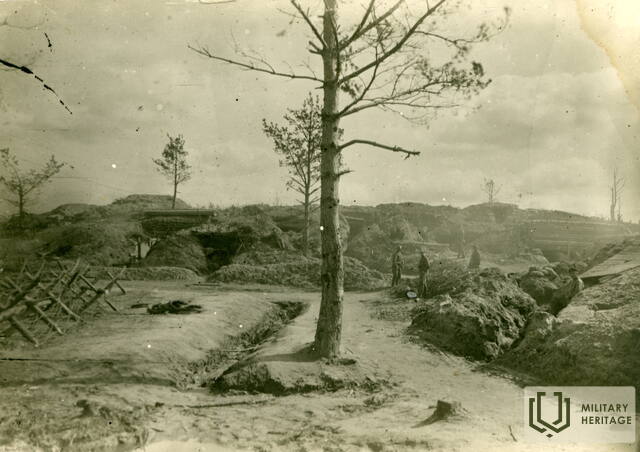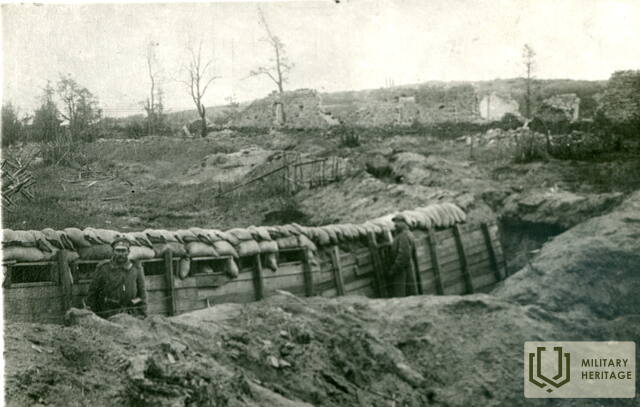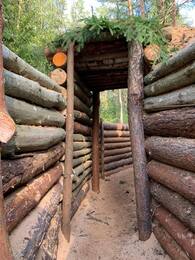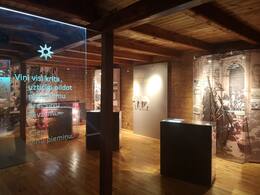Latvijos šaulių kasdienybė Mirties saloje
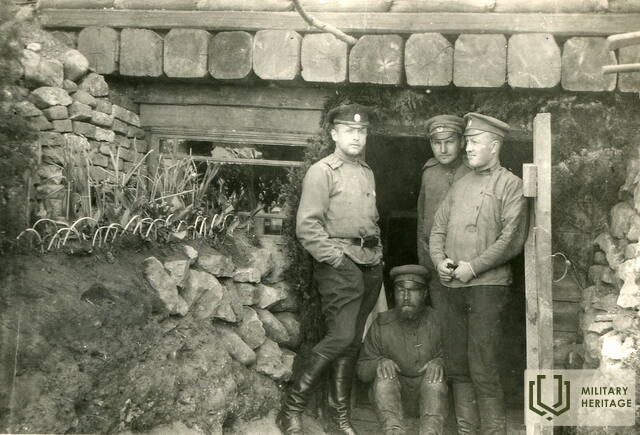
Memuaruose vaizdžiai aprašomas kareivių kasdienis gyvenimas Mirties saloje.
„Gyvenimas Mirties saloje buvo kupinas vargo ir siaubo. Naktį, sutemus ir iki aušros, į mūšio lauką buvo pristatomos karo medžiagos ir maistas, sužeistieji ir žuvusieji buvo vežami į dešinįjį krantą. Sugriuvę apkasai ir susisiekimo praėjimai, pažeistos telefono linijos buvo skubiai suremontuotos. Priešas nemiegojo. Minų sviediniai sprogo virš šaulių apkasų. Veikė kulkosvaidžiai. Tik ketvirtadalis salos garnizono galėjo trumpam užmerkti akis. Likusieji turėjo būti budrūs. Tik auštant pasikeisdavo naktinė sargyba. Maistas ir virintas vanduo dideliais konteineriais buvo pristatomi į pirmuosius apkasus 10 ir 18 val. Nepaisant siaubingo gyvenimo Mirties salos sargybos postuose, šauliai visada buvo pakilios nuotaikos. Jie visais įmanomais būdais stengėsi sukurti permainų ir linksmybių varginančiame poziciniame mūšyje. Nors šauliai gyveno smeigių uolose ir rausėsi žemėje, mirtis šešėliuose, savo žemės olose ir iškastose duobėse buvo matomos net sodo gėlės ir drovios kaimo gražuolės. Žvalūs latvių berniukai – šauliai juos atsivežė iš...“ „neutrali žemė“, kuri buvo tarp šaulių ir vokiečių apkasų. Žinoma, tai buvo naktinis darbas, jiems nebuvo leista dieną pasirodyti už apkasų ribų. O nakties metas buvo tarsi sukurtas visokioms išdaigoms. Gudrus šaulys vokiškos granatos cilindrą pavertė gėlių vaza. Jis mėgo poeziją knygose ir gyvenime. Bet toks jau yra latvis – jis moka rasti grožį ar jį sukurti net tamsiausiomis gyvenimo valandomis. Nevystančios gėlės šaulių apkasuose ir nevystančių dainų skambesys net sunkiausiomis nevilties akimirkomis. Šaulių karas buvo šventa užduotis ir net vokiečių audra negalėjo nutildyti jų širdžių džiaugsmo. Rytais ir vakarais, kai mūšio triukšmas paprastai jau būdavo nurimęs, šauliai šias poilsio akimirkas praleisdavo giedodami liaudies dainas. Vokiečiai atsakydavo dainuodami savo karo dainas. Dažnai abu priešininkai apkasuose grodavo mandolinomis ar gitaromis. Atrodė, kad jie nebe priešai, o tarp dviejų priešininkų užsimezgė draugystė. Kartais rytais ir vakarais tarp mūsų susiklostydavo taikiausi santykiai... ir priešininkas egzistavo, bet sutemus prasidėjo abipusės kovos iki mirties. Netgi ramiai, didžiai, taikiai Latvijos likimui, juodajai Dauguva, nebuvo leista ramiai banguoti. Joje dažnai iškildavo aukštos vandens kolonos, sukeltos vokiečių granatų, kurių purslai krisdavo atgal į Dauguvą, drumsdami jos ramybę. Šimtai negyvų ir apsvaigusių žuvų plaukė pasroviui. Šauliai bandė tuo pasinaudoti ir bandė pagauti „sutrikdytas“ žuvis pasroviui nuo šaudymo vietos Dauguvoje, o po geros medžioklės valgė vokiečių jiems parūpintą žuvieną. Medžioklė buvo ypač sėkminga, kai žemutinėje Dauguvos pusėje buvo pastatytas plaukiojantis tiltas. Apskritai, kad ir kiek vokiečių artilerijos ugnis apšaudymo metu buvo pavojinga ir mirtina fiziškai bei morališkai, jai nutrūkus, ji suteikdavo malonių akimirkų šauliams. Kol ugnis dieną nenurimdavo, visi eidavo į daubas ieškoti vokiškų sviedinių aliuminio ir vario galvučių. Dažnai šauliai būriais puldavo į nukritusio sviedinio vietą. Kam? Bet tie, kurie patyrė šaulių laikus, prisimins, kad beveik visi... Šauliai, kurie porai dienų atostogaudavo Rygoje arba pas gimines, ant pirštų nešiodavo tokius keistus, baltus žiedus. Tai buvo šaulių išradimas ir kūrinys. Aliuminis buvo pašalinamas iš sviedinių galvučių ir išlydomas. Reikiama forma prieš tai būdavo išpjaunama iš gipso ir tada išliejama! Šauliai gamino įvairių formų žiedus: žiedus su širdimi, labai išraiškinga žvaigžde, į kai kuriuos žiedus buvo įlydyta granatos šukė ir pan. Šauliai mėgo šiuos žiedus, nes jie ryškiai priminė viską, ką jie patyrė ir patyrė Mirties saloje. Šauliai iš tos pačios medžiagos liejo ne tik žiedus, bet ir gamino šaukštus, mažas figūrėles ir kitus įdomius daiktus. Iš rankinių granatų degiklių varinių vamzdelių pradėti gaminti kandikliai, pašalinant iš jų sprogusį gyvsidabrį. Žinoma, pasitaikydavo ir nelaimingų atsitikimų, ir vienas ar du šauliai netekdavo ne tik pirštų ir rankų, bet ir gyvybės. Visos nesprogusios vokiškos granatos ar skeveldros buvo palaipsniui išardomos, iškraunamos ir paverčiamos vazomis, semtuvais, o dauguma jų buvo išsiųstos namo giminaičiams kaip mielas prisiminimas iš... mūšio laukas. Šis karas šauliams buvo šventas karas, ir viskas, kas susiję su mūšiais, tapo šventa ir verta atminimo. Nors šaulių dvasia buvo gyvybinga ir pasitikinti savimi, jie negalėjo netikėti savo pergale, lygiai taip pat rūpinosi savo karo ginklų priežiūra ir saugojimu, o tai taip pat labai svarbu kareivio gyvenime. Pagrindinis šaulių ginklas buvo šautuvas. Jis buvo jų draugas ir geromis, ir blogomis dienomis. Ne veltui šauliai laiškuose ją vadino savo „žmona“ ir „nuotaka“. Mirties saloje buvo galima pamatyti šaulius, valančius savo šautuvus, deginančius drabužius, batus ir kt. Kai šautuvai būdavo nuvalomi, jie būdavo dedami į specialiai paruoštus vertikalius stovus tiesiai apkasuose, kad bet kurią akimirką būtų po ranka ir galėtų būti nedelsiant pradėti dirbti.
http://latviesustrelniekusaraksts.lv/Kaujas_darbiba/Book_2.html (žiūrėta 2021-07-20)
Susijusi laiko juosta
Susijusios temos
Susijusios vietos
Mirties sala
Salų grupė yra Dauguvoje, Rygos HE rezervuaro pietinėje pusėje, netoli Daugmalės. Mirties sala yra vienas baisiausių ir legendomis apipintų Pirmojo pasaulinio karo mūšio laukų. Kai 1915 m. Rusijos armija pasitraukė iš Kuržemės ir Žiemgalos, kai kurie daliniai liko kairiajame Dauguvos krante, kur užėmė pozicijas kovai su Vokietijos armija. Upės krantus jungė tiltas. Čia įvyko vienas didžiausių cheminio ginklo panaudojimo atvejų Latvijos teritorijoje. Latvijos kareiviai šią vietą vadino „Mirties sala“, o kitų tautybių kareiviai – „Pragaru“. Mirties salos vieta turėjo strateginę ir simbolinę reikšmę. Latvijos kareiviams ji buvo Vokietijos okupuotos Kuržemės dalis. Kovos vyko Dauguvos pakrantėse netoli Ikškilės, kurios tam tikra prasme buvo susijusios su protėvių kovomis kryžiaus žygių metu. Šiandien į šią vietą galima patekti laivu. Galima pamatyti neužtvindytą Rygos HE rezervuaro teritoriją. Vis dar išlikęs E. Laubės suprojektuotas paminklas. Kai kuriose vietose rekonstruoti gynybinės pozicijos elementai. Dauguvos krante, netoli Ikškilės Kābelių kalvos, yra informacinis stendas. Mirties sala tapo salų grupe, kai buvo baigta statyti Rygos HE rezervuaras.
Kultūros paveldo centras „Tīnūžų dvaras“
Kultūros paveldo centras „Tīnūžių dvaras“ yra Ogrės savivaldybėje, Tīnūžių kaime, 7 km nuo Ogrės ir Ikškilės miestų. Pirmieji rašytiniai duomenys apie dvarą siekia XVI a. Iki XVIII a. vidurio jis buvo laikomas ekonominiu gamybos vienetu su mažais ir nereikšmingais pastatais. Tačiau laikui bėgant jis išaugo į didelį ūkį. Pirmojo pasaulinio karo metu čia vyko Rusijos ir Vokietijos armijų mūšiai, kuriuose dalyvavo ir Latvijos šauliai. Nepriklausomybės karo metu Tīnūžių dvaras buvo naudojamas kaip Latvijos armijos 1-ojo Valmieros pėstininkų pulko štabas ir šarvuočių aikštelė. 1932 m. dvaras buvo perduotas Latvijos karo invalidų sąjungai, kuri apgyvendino ir rūpinosi karo veteranais. Antrojo pasaulinio karo metu (1943 m.) iš Estijos į Tīnūžių dvarą buvo perkeltas Vokietijos armijos dalinys FAT 212. Tai buvo diversantų dalinys, rengęs karius kovai su Raudonąja armija. Latvijos kareiviai taip pat buvo apmokyti žvalgybos rinkimo, partizaninio karo taktikos ir sabotažo menų. Tīnūžių dvaro pono rūmai buvo sugriauti, kai Raudonoji armija judėjo Rygos link. Šiandien tai vieta su nuostabiu kraštovaizdžiu ir istoriniais pastatais Mažosios Juglos upės pakrantėje. Kultūros paveldo centre „Tīnūžių dvaras“ galima pamatyti ekspozicijas, skirtas istoriniams įvykiams, įskaitant ir tas, kurios susijusios su Latvijos šauliais.





